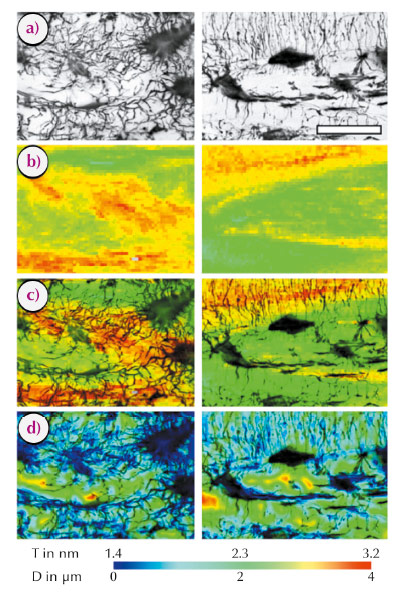- Home
- Users & Science
- Scientific Documentation
- ESRF Highlights
- ESRF Highlights 2013
- Soft condensed matter
- The influence of osteocytes on bone material
The influence of osteocytes on bone material
Bone is a unique biological material made of inorganic hydroxyapatite particles that are embedded in an organic matrix of collagen [1, 2]. Bone is constantly being remodelled by bone cells, namely osteoblasts and osteoclasts. Osteocytes, another type of bone cells, are thought to be involved in mechanosensing, that is, they respond to external mechanical stimuli and thereby control bone remodelling. It is also suspected that they have a direct impact on the mineral homeostasis, by depositing and resorbing some of the bone mineral. Osteocytes form a spatial network of lacunae (voids in which the cells reside) and canaliculi (interconnecting the lacunae) throughout the bone. The total surface of this network in adult humans is enormous and, thus, it is conceivable that osteocytes interact with their surrounding material. In this case, bone material adjacent to osteocytes and their cell processes should show traces of osteocytic action and thus express different mineral properties.
In this study, we first visualised the osteocyte network topologically in different bone sections by confocal laser scanning microscopy. These three-dimensional datasets were quantified by computational methods to characterise density and organisation of lacunae and canaliculi. In the same sample regions, scanning small-angle X-ray scattering (SAXS) was performed at beamline ID13 with an effective beam size of 1 µm. This high resolution was needed to resolve potential inhomogeneities of bone material in relation to the osteocyte network architecture. We analysed mineral particle size and arrangement in the immediate vicinity of the osteocyte cell network and compared it with the corresponding properties further away from the cell network. The measurements were performed on fibrolamellar ovine bone sections. Due to the high scanning resolution, measured areas with sizes in the order of 200 x 150 µm consisted of several thousand data points.
The high resolution maps of mineral particle orientation and thickness reveal a strong correlation with structural features of the osteocyte network (Figure 86). Our results show a distinct structural organisation of bone material in the direct vicinity of the osteocytes compared with areas further away from the cells. The osteocyte cell network in the studied bone sections features areas of dense (mineral near cells) and loose (mineral far from cells) network organisation (Figure 86a). The values for bone mineral particle thickness in these areas are in the range of about 2.3 nm to 3 nm. We find gradients around osteocyte lacunae with thinner particles in the immediate vicinity of osteocytes (Figure 86b and 86c). However, the average mineral particle thickness in areas with loose cell network organisation is in the range of 2.3 nm, which is thinner when compared with mineral particles present in areas with densely organised osteocytes (around 3 nm). This relation becomes even more apparent after plotting the distance between mineral and the nearest cell which can be calculated from the microscopy (CLSM) images (Figure 86d). Here a strong correlation between large T-parameters and short mineral – cell distances is found.
 |
|
Fig. 86: Osteocyte network organisation and mineral particle thickness (parameter T) in fibrolamellar ovine bone: (a) CLSM image showing areas of dense and loose osteocyte network organisation, (b) parameter T, (c) T merged with CLSM, (d) calculated mineral – cell distance (D) merged with CLSM. Mineral particle thickness is elevated in areas of shorter mineral – cell distances (densely organised osteocyte cell network). Scale bar 20 µm. |
Such unorganised bone material featuring rather loose osteocyte cell network organisation is usually found in so-called woven bone which is known to be primarily deposited during osteogenesis [3]. Even though this bone type is highly mineralised [1, 3], we find that the average mineral particle thickness is substantially lower than highly organised bone deposited during later stages of bone development. This may denote that, during rapid processes of initial mineralisation in woven bone, more mineral crystals are nucleating simultaneously to reach higher degrees of mineralisation in shorter periods of time. Consequently, due to spatial constraints, higher packing of particles leads to smaller final mineral particle dimension.
In conclusion, our scanning SAXS measurements on bone show interesting local inhomogeneities of submicrometre material properties that correlate with the architecture of the osteocyte network. It is notable that the majority of the mineral is located within less than one micrometre from the cellular network and that mineral particle properties depend on the local density of the cellular network and on the distance from cells and blood vessels. The results of this work improve the understanding of the active role of osteocytes during dynamic processes of bone formation and remodelling and support the hypothesis that osteocytes directly contribute to bone mineral homeostasis.
Principal publication and authors
M. Kerschnitzki (a), P. Kollmannsberger (a, b), M. Burghammer (c), G.N. Duda (d), R. Weinkamer (a), W. Wagermaier (a) and P. Fratzl (a), J Bone Miner Res 8, 1837 - 1845 (2013).
(a) Max Planck Institute of Colloids and Interfaces, Potsdam (Germany)
(b) ETH Zurich (Switzerland)
(c) ESRF
(d) Charité, Berlin (Germany)
References
[1] S. Weiner and H.D. Wagner, Ann Rev Mater Sci 28, 271-298 (1998).
[2] P. Fratzl, H.S. Gupta, E.P. Paschalis and P. Roschger, J Mater Chem 14, 2115 - 2123 (2004).
[3] M. Kerschnitzki, W. Wagermaier, P. Roschger, J. Seto, R. Shahar, G.N. Duda, S. Mundlos and P. Fratzl, J Struct Biol 173, 303 - 311 (2011).



